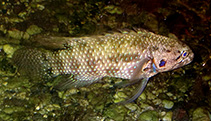| Family: |
Plesiopidae (Roundheads), subfamily: Plesiopinae |
| Max. size: |
18 cm TL (male/unsexed) |
| Environment: |
reef-associated; marine; depth range 1 - 23 m |
| Distribution: |
Indo-Pacific: Madagascar to the Line Islands; north to southern Japan, south to the southern Great Barrier Reef and Tonga. Throughout Micronesia. |
| Diagnosis: |
Dorsal spines (total): 12-12; Dorsal soft rays (total): 7-8; Anal spines: 3-3; Anal soft rays: 8-8. Coloration can vary from pale gray with black blotches and blue dots to an almost uniformly black except for the ever-present blue ocellus on the edge of its operculum.
Description: Characterized by gill cover with pale-edged dark spot; tubed lateral line scales 18-21+7-14; midlateral scale series 23-25; cheek scale rows 4-6 (Ref. 90102). |
| Biology: |
Adults are benthic which occur inshore (Ref. 7300). Relatively common on reef flats, searching under rocks or in crevices for small fishes and crustaceans which serve as food (Ref. 1602). Common, but hidden in holes by day. They venture out to feed on small invertebrates and fishes at night (Ref. 9710). Apparently, gastropods form an important component of the diet as indicated by X-ray radiographs (Ref. 27772). Eggs are guarded by the male parent (Ref. 205). Minimum depth reported from Ref. 27115. |
| IUCN Red List Status: |
Least Concern (LC); Date assessed: 12 August 2019 Ref. (130435)
|
| Threat to humans: |
harmless |
Source and more info: www.fishbase.org. For personal, classroom, and other internal use only. Not for publication.

